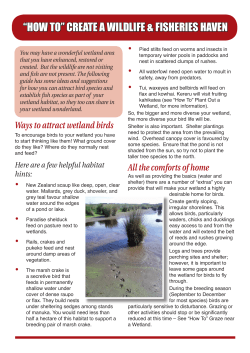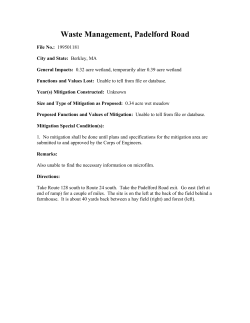
Gwen Finch Wetland management plan Sep14
Gwen Finch Wetland – a summary of the management plan Brief Description The Gwen Finch Wetland Reserve is located in a loop of the river Avon, near the village of Birlingham, grid reference SO 940 420. The site was created in 2001 from former arable fields. On the 20 hectare site there is an area of wet woodland, four scrapes, reedbed and a flooded channel fringed with reed, these latter are filled using two windpumps that extract from the Berwick Brook that flows into the River Avon. The majority of the rest of the site is given over to wet grassland. Ecologically the site is important for otters, wetland birds like lapwing and redshank, as well as reedbed specialists such as reed bunting, sedge and reed warblers. There are also good populations of insects, particularly dragonflies with the locally scarce club tailed dragonfly recorded here. Since establishment the site has been used as an example to other landowners along the Avon as a demonstration wetland creation site, and has helped in the development of the neighbouring John Bennett Reserve due for creation in 2010. The reserve falls within, and is an important component of, the Severn and Avon Vales Living Landscape, which has been identified as a target area for the Trust to try and increase biodiversity through partnership working with other landowners Area. There is no public access. Access is by arrangement only. Management aims The primary aims for the reserve are to create wetland habitats for otter, wet grassland habitat suitable for lapwing and redshank breeding, and maintain the reedbeds in suitable condition to encourage breeding reed buntings, sedge and reed warblers. Secondary aims are to fulfil the conditions of the current Higher Level Stewardship agreement, and maintain the wet woodland. Rationale Reedbeds are not common or extensive in Worcestershire, although they do have a general distribution. They are found throughout the county mainly as narrow fringes of reed along rivers, canals and ditches rather than extensive areas. Existing knowledge of reedbeds across the county estimates the bulk of the total resource at around 26 hectares on over 20 sites. The largest areas are in the order of 5 hectares at Hewell Park Lake Site of Special Scientific Interest and along the Droitwich Canal. The Gwen Finch Wetland was created to bolster this resource, and to act as a demonstration site to encourage further reed bed creation. The scrapes are also essential to provide feeding opportunities for wading birds, and marginal vegetation for aquatic invertebrates. The grassland is managed to provide suitable conditions to support breeding waders. Through grazing the management aims to create a mosaic of short and tussocky areas suitable for lapwing and redshank to breed. Ranker areas are also left to offer cover for other birds and to provide a seed source in the winter. The bank of the river has been re-profiled to create a broad emergent zone at or just above summer flows. This was intended to encourage the development of emergent vegetation to benefit a range of species including otter, waterfowl and dragonflies. There are also a number of old willows that are maintained by pollarding that are a landscape feature and have intrinsic ecological value. Summary of Management Grassland area: Use grazing to maintain a mixed sward of low and tussocky areas. Maintain moist ground conditions during the breeding season. Reedbed: Annual cut of up to 1/5th of reeds to reduce leaf deposition Maintain scrub to allow a maximum of 10% cover. Maintain open water and muddy margins on the scrape and control water depth. Monitor bird species present on site, ensuring breeding records as a minimum. Wet woodland: Maintain extent of wet woodland, and keep some wet dead wood. Record presence/absence of otter Bullen’s Brook: Maintain water level in the brook. Bankside: Pollard willows on rotation Infrastructure: Service windpumps annually Community: Run at least one walk for the local community.
© Copyright 2025














